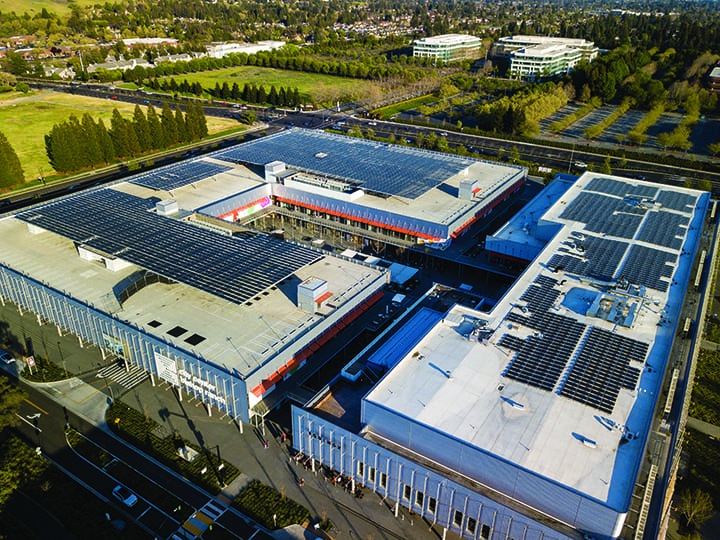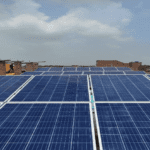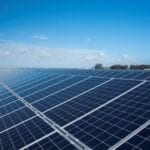Government support, lower costs, and technology advancements are among the bright spots as rapid growth continues.
Solar power has long been part of the global push for renewable energy, and power industry analysts say it may only have scratched the surface of its potential. Solar led all power sources in terms of added generation capacity in 2020; a March report from the Solar Energy Industries Association (SEIA) says the U.S. added a record 19.2 GW of new capacity last year, a 43% increase from 2019. The group said utility-scale installations in 2020 experienced a 65% increase from 2019.
The story is much the same worldwide. Analysts predict 20% growth in China this year, as much as 30% growth in the U.S., and have said India, Latin America, and the Middle East all could see as much as a 60% increase in solar deployment in 2021.
U.S. solar installations are expected to quadruple from current levels by 2030, according to the SEIA report. The group said the U.S. today has more than 97 GW of installed solar power generation capacity. SEIA said that in the last three months of 2020, the U.S. installed just more than 8 GW of new generation capacity, a record for any quarter, and more than all the capacity—7.5 GW—added in 2015. And U.S. growth, certainly at least in the next few years, will be supported by new tax credits and subsidy incentives from the federal government.
Want to learn more? Go here to read how new technology, including drones and 3D modeling, is helping solar panel installers with the design of their rooftop arrays.
“The American Jobs Act (AJA) proposes approximately $2 trillion for infrastructure and climate change,” said Mike Bammel, managing director at JLL, which provides advisory and capital structuring services for renewable energy developers. “Although the AJA must go through the legislative process, it is encouraging for the solar power sector,” Bammel told POWER. “The federal government can use its purchasing power to drive innovation and clean energy, which in part would target rehabilitating and retrofitting schools, veterans’ hospitals, and federal buildings, for example.”
 |
|
1. Commercial and industrial facilities are increasingly producing their own power, often from solar. Distributed Solar Development (DSD) designed and installed this rooftop array at City Center Bishop Ranch, a shopping center in San Ramon, California. The solar installation at the site produced about 2.15 GWh of electricity in the past year. DSD in late April said it had broken ground on a solar-plus-storage installation at the nearby Bishop Ranch business park. Courtesy: DSD |
The recent two-year extension of the federal investment tax credit (ITC) for solar projects is expected to support installations (Figure 1) at least through 2025, analysts have said. That ITC, coupled with increasingly lower costs for solar power, should help solar maintain the top spot in terms of new electricity generating capacity.
“Solar now has support across the political spectrum, and ‘solar installer’ has been one of the fastest-growing jobs in many states over the past few years,” said Billy Parish, CEO of Mosaic Solar, a California solar financing company. Parish told POWER, “Currently, only about 2% of homes have solar, so we have decades of significant job creation opportunity in solar construction and installation.”
Mark Sylvia, chief of staff of Boston, Massachusetts-based BlueWave Solar, talks about the growth prospects for the industry and provides insight into the challenges facing the solar sector in this POWER Interview.
Erin Decker, director of CleanTech Client Management at Schneider Electric, told POWER, “As one of several forms of renewable energy, solar power will play a key role in achieving the Biden administration’s goal to reduce CO2 emissions by 50% by 2030 … the sector is likely to get a boost through both administration efforts and legislative changes, depending on what kind of bills Congress ends up passing.”
Those directly involved in providing solar installations and energy efficiency services know the importance of government support for their business. Jayson Waller, founder and CEO of POWERHOME SOLAR, which provides solar installations and services in 15 states, told POWER, “As for potential upcoming policy changes, it is our hope that any future changes will reflect the growing value of solar across the U.S. Each day, thousands of people are learning about the benefits of solar power as it becomes more widely understood. Homeowners are discovering how their solar power rooftop panels paired with battery storage can help in many ways from potential savings in monthly electric bills to providing protection in case of power outages, and how they can use this stored energy during times of peak demand, when costs for electricity are higher. Clean energy, savings, and improved energy efficiency are things we can all get behind.”
New Technologies
The rapid development of new technologies has a major role in solar’s expansion. The use of perovskite, a crystal-based mineral consisting of calcium titanium oxide, could bring efficiency improvements; the National Renewable Energy Laboratory has confirmed perovskite can convert more incident solar energy into electricity than traditional silicon cells. Research into molten salt, which can transport heat in solar power systems, is helping with solar efficiency and storage capacity, while reducing costs.
The introduction of module-level power electronics (MLPE) to inverter topology has been an important innovation. By moving functionality to the panel level, this distributed inverter topology has brought new value, providing more energy, high-resolution monitoring, design flexibility, and enhanced safety.
“Software will be the ultimate disrupter,” said James (JD) Dillon, chief marketing officer of Tigo Energy, a global company that develops MLPE solutions to enhance safety, increase energy production, and decrease operating costs of photovoltaic (PV) systems. “Beyond software, storage technology must get better, and fast. The demand is staggering and there are far fewer competitors than the inverter and panel space.”
Dillon told POWER “rapid improvements in [storage] technology are required to overcome the most logical problem with solar—the technology produces perishable energy during the day, but we use the most energy in our homes at night.”
Norm Taffe, executive vice president of SunPower, a commercial and residential solar/storage provider, also said software is key. “While PV technology will continue to advance, the most significant technological achievements toward the mass adoption of solar in the next five years will take place in software,” Taffe told POWER. “Mobile applications are making it easier for consumers to understand, manage, and optimize their energy usage, and the industry should take a software-first approach to everything from permitting to battery storage use. Widespread adoption of solar will require us to rethink the way our grid is structured, and software innovation will be key in building a distributed grid of solar installations.”
“AI [artificial intelligence] and predictive technologies will minimize the risks associated with solar power production,” Muhammad Malik, CEO and founder of NeuerEnergy, told POWER. “We can expect to see more energy providers adopt an intuitive API-based [Application Programmable Interface] platform, particularly one that uses AI with SaaS [software-as-a-service] applications, to gain real-time intelligence into the risks associated with solar power production. This includes ongoing fluctuations in market price, which coupled with declining governmental subsidies can increase costs for energy production. With operational maintenance adding additional expense, this often leads to reduced margins for energy generators and increased costs of service.”
Said Malik: “Now, solar power providers can adopt AI and machine learning technologies to maintain operational efficiency and streamline costs. Sensor and climatic data, for example, can be correlated to predict energy needs ahead of time, according to seasonal variations, and align demand with grid load and outages. AI technologies will correlate all of this real-time intelligence with historical data to predict potential downtime and suggest actions accordingly—saving a magnitude of time, money, and personnel.”
Batteries and CSP Improvements
Waller, whose company is based in North Carolina, told POWER that, “Solar batteries will be the biggest advancement in the sector in the next five years because they create opportunities for homeowners to be less reliant on the grid. This is huge because when solar-produced electricity is stored, it can be used to save on monthly electric bills and provide protection in case of power outages.”
Engineers at Purdue University are working on cost-cutting measures for solar, in particular developing ways to improve how concentrated solar power (CSP) plants produce electricity. These types of plants can provide power at off-peak times by storing heat captured from sunlight that is focused by thousands of mirrors onto a small area. Though solar-plus-storage systems are becoming more prevalent, CSP installations can offer large-scale energy storage at a lower cost, according to the Purdue group.
“Since storing solar energy as heat is already cheaper than storing energy via batteries, the next step is reducing the cost of generating electricity from the sun’s heat,” said Kenneth Sandhage, Purdue’s Reilly Professor of Materials Engineering, in comments shared with POWER.
 |
|
2. By improving the molten salt used for low-cost heat storage at higher temperatures, researchers can help concentrated solar power plants to generate electricity more efficiently and cheaply. Courtesy: Rebecca McElhoe/Purdue University |
The group said there are just 11 CSP facilities in the U.S., and said the cost of producing electricity using these plants has dropped by more than 50% since 2010. The Purdue researchers think it can go lower by improving the molten salt (Figure 2); they said that would enable “low-cost storage of solar heat at higher temperatures so that the plants can produce electricity 24 hours a day and respond quickly to surges in electrical demand.”
Global Growth
Southeast Asia also is experiencing record growth in solar. For example, Assaad Razzouk, group CEO at Sindicatum Renewable Energy, a clean energy projects operator, recently shared information about how Vietnam became the biggest solar generator in the region, after having almost no solar power generation two years earlier. Razzouk said Vietnam “installed solar equivalent to six coal power plants in one year [2020], boosting its solar capacity by 25,000%, including a record 6.71 GW of rooftop solar in just one month,” which he said is equal to two-thirds of France’s total installed solar generation capacity.
The Institute for Energy Economics and Financial Analysis reported homes and businesses in Vietnam installed nearly 100,000 rooftop systems across the country last year, and Vietnam also built its largest solar farm—the 450-MW Trung Nam Thuan Solar Power Plant—in just five months, bringing it online in October after construction began in May. Vietnam’s solar capacity is now 16.5 GW, already ahead of its 2025 target of 12.5 GW of installed capacity.
That growth came despite the impact of the coronavirus pandemic, which caused supply chain disruptions. The solar industry was hit particularly hard, because much of the industry’s equipment is manufactured in China. However, the pandemic likely contributed to growth in residential solar installations. SEIA said residential solar additions led to a record-setting sales pipeline in the second half of 2020, as remote work situations led to home improvements, a trend that is likely to sustain growth in 2021.
“While there were some slowdowns at the beginning of the pandemic related to construction and material issues, we have since seen new solar power purchase agreements [PPAs] get executed by corporations and solar projects are continuing to come online,” said Decker.
Taffe agreed. “The combination of the switch to spending more time at home, and news-making crises like the California wildfires and Texas power outages, have boosted interest in solar and storage among consumers,” he said.
Pandemic Impacts
Those who spoke with POWER agreed that COVID-19 has forced companies to take a look at their business models across the solar space, though they noted the pandemic had differing impacts.
“We did not experience a significant supply chain disruption, and that is for two reasons,” said Waller. “First, since 2017, we have been using only American-made panels for our residential installations, and second, we communicated with our suppliers on an ongoing basis. By doing this, we were kept apprised of any changes in production, deliverables and adjusted our installation timelines accordingly.”
Said Taffe: “COVID-19 had a larger impact on sales channels than the supply chain during the pandemic’s early stages. Our industry has traditionally relied on door-to-door sales and in-person consultations, and a country-wide shift to remote work required solar companies to develop high-functioning digital sales tools. We were prepared for this shift, already making investments in our digital technology, and were able to quickly move from 95% in-person sales to 85% digital sales within months.”
It’s clear, though, that the pandemic forced many in the solar industry to rethink their strategies, particularly as it relates to reliance on equipment from China.
“I’ve seen a significant impact” from the pandemic, said Miriam Tuerk, CEO of Clear Blue Technologies. She told POWER that issues with the solar power components supply chain showed the need to increase equipment manufacturing outside China.
“Numerous countries see cleantech as a growth industry that will create many jobs; however, given that COVID-19 triggered a lot of global government spend on jobs within the cleantech sector, the movement of the industry away from China should accelerate,” Tuerk said. “I believe that everyone now understands that local and diversified global sources are key to having a robust business.” ■
—Darrell Proctor is senior associate editor for POWER (POWERmagazine).










